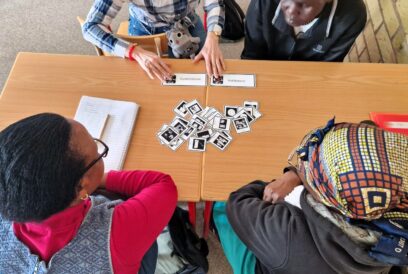

There is a deep digital divide between older and younger citizens in Portugal, where many senior citizens are vulnerable to digital exclusion. Image: Shutterstock
There is a deep digital divide between older and younger citizens in Portugal, where many senior citizens are vulnerable to digital exclusion. Image: Shutterstock
In Portugal only slightly over one third of senior citizens use the internet. In order to fight this digital exclusion, more must be done, researcher Celiana Azevedo argues.
Celiana Azevedo is a researcher specialising in gerontechnology, interdisciplinary academic field combining gerontology and technology. According to her, the situation of the senior citizens of Portugal is worrying: they are vulnerable to digital exclusion.
Azevedo says that while the group with most new internet users are the elderly, the numbers are still low as, according to data from 2019 only 34.1 percent of the seniors (65–74-year-olds) use the internet. This reflects a deep digital divide between them and the younger citizens.
Moreover, the Portuguese elderly are disadvantaged in comparison to the elderly in other EU countries. According to Eurostat (2017), 27 percent of EU citizens aged 65–74 used the internet to interact with public authorities, while in Portugal this percentage is only 14.
Digital inclusion is related to access to public services.
In this context, it is also worth pointing out that Portugal is a so-called aging country, as 26.7 percent of the citizens are 60 or older.
The consequences of the divide for seniors can be significant on many levels, as is explained in Azevedo’s recent book, Demasiado Velho para o Digital? (2019), which discusses active aging and the use of ICT in Portugal and Brazil.
According to the book, those who have access to internet and ICT skills usually feel more independent as they can, for example, take care of their finances online. There is also a social dimension, as contacts with family and friends can be maintained online. Moreover, digital inclusion is related to access to public services.
Social and digital exclusion go hand in hand
Digital exclusion is related to social exclusion, as is pointed out in Azevedo’s book. In general, the seniors who are vulnerable in social terms also tend to be susceptible to digital exclusion. Some of the reasons for not using ICT include lack of an internet connection at home or in public spaces, as well as the price of digital devices.
In her research, Azevedo also cites Isabel Dias’ studies from 2012. Dias’ quantitative study is based on surveys in the cities of Lisbon, Porto and Coimbra, and she points out that the low level of education of the Portuguese elderly plays a significant role in access to ICT, or lack of it. According to PORDATA (the Database of Contemporary Portugal), in 2018 21.2 percent of those 65 years or older had no formal education at all.
Moreover, according to Dias’ research, there is also a gender gap: there are more elderly women than men who have not used the internet.
Those who are interested in gaining ICT skills can be hard to reach too. Azevedo says that in Portugal digital skills are most often taught through projects that involve local government, universities or day centres. “This limits the access for the majority of the elderly,” she points out.
Interest in gerontechnology is growing
Azevedo says that in the last 10 years there has been more interest in Portugal towards the area of gerontechnology. This is related to wider issues concerning the aging of society.
“The interest has been fed by public and private policies that seek to soften the social and consequently economic impacts of aging,” Azevedo explains.
The family unit can provide an excellent atmosphere for learning how to use ICT and gain deeper knowledge.
The issue of the digital divide has been acknowledged, and according to Azevedo there have been various initiatives promoting digital inclusion. “However, they have not been sufficient to reduce the significant differences between the younger and the older,” she adds.
New approaches are required, especially as the Portuguese government wants 95 percent of the citizens to be using the internet by 2030. As Azevedo writes in her book, this means that the efforts should be made particularly with the elderly population in mind.
“What is often forgotten is that the family unit can provide an excellent atmosphere for learning how to use ICT and gain deeper knowledge,” says Azevedo.
In practice, this means that the younger members, usually the grandchildren, teach the older. In this context, the elderly also have the chance to share their life experiences. “This kind of exchange benefits both generations.”
Author







